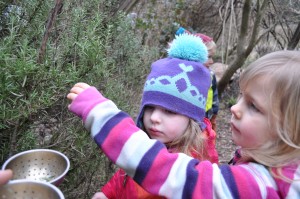Embodying Permaculture

Originally appears in the Spring 2014 issue
DRIPS FROM THE MORNING RAIN fall from the maple leaves and fir boughs in random staccato, occasionally landing on the heads of children as they walk down the wooded path to their outdoor school. Jumping in puddles and hopping over cedar tree roots, their voices echo and occasionally startle small birds into flight. The movement may only be seen from the corner of your eye, because the main delight of the moment are the salmonberries that have ripened just uphill from the edge of the path. The children position themselves on tip-toes in order to reach the berries. It’s a delicate game of balance and care; if they squeeze too hard, the berries will fall apart. They also need to be mindful of the stinging nettle growing nearby.
Developing brains are quite literally customized to learn in response to direct sensory experiences with the natural world. In the description above, nature is already teaching valuable lessons before the children even arrive to their class. Before age seven, learning is most effective when experienced through the bodily senses. The introduction of formal academics is not necessary until later in their life and growth. Early childhood is a time of development unlike any other, and can be described as the child “waking up” into their bodies and relating to the world around them. The primary role of the educator is to support the integration of this inner awakening and outer-relating by guiding and facilitating physical and social experiences that validate this journey.
Nature provides a full spectrum of sensory stimuli that are healthy for child development, and has an important role in the design of an early education program. By considering the educator’s role as a designer, we gain extra insight into how the process of teaching affects the outcome of learning. How we do something is as important as what we do.
Permaculture design recognises that any single action always has more than a single consequence. It challenges our creative capacity to maximize the beneficial functions of our actions—whether planting a garden or leading a class—and minimize any unintended consequences of these actions. Once a practice becomes intuitive rather than merely intellectual, it is considered embodied permaculture: a natural reflex that is both intentional and mindful.
To view the photo-rich magazine version, click here.
If you are not already a subscriber, please subscribe to read the full article
Matthew Bibeau and Kelly Hogan are the directors of Mother Earth School, a farm and forest-based school (currently enrolling preschool through second grade) in Portland, Oregon. They are also the instructors of a week-long training in Permaculture for Youth & Child Educators. Learn more at www.motherearthschool.org.
Leave a Reply
You must be logged in to post a comment.










